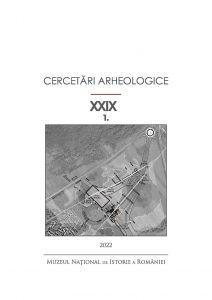Artefacte medievale timpurii descoperite în fortificația de pământ de la Coșeiu - Cetate/Várhegy/Hegyes (jud. Sălaj). Un posibil centru de putere în preajma anului 1000
Early Medieval artifacts discovered in the earth fortress from Coșeiu - Cetate/Várhegy/Hegyes (Sălaj County). A possible power center around the year 1000
Author(s): Dan Băcueț-Crișan, Horea PopSubject(s): Archaeology, Middle Ages
Published by: MUZEUL NAȚIONAL DE ISTORIE A ROMÂNIEI
Keywords: early medieval artifacts; fortress; power center; silver pendant; iron arrowhead;
Summary/Abstract: The site is located on a hill north of the village. The fortress was identified in 2017, the earthwall and the ditch being visible on the ground surface. In 2017 - 2019, several archeological diggings were carried out here. The batch of archeological material discovered during the excavation (in 2019) of the fortified enclosure includes two artifacts that certainly belong to the early Middle Ages: a circular silver pendant and an iron arrow. At the current stage of research, in the case of the Coșeiu - Cetate/Várhegy/Hegyes fortress, we operate with artifacts dating around the year 1000, a chronological stage in which the north-western space of Romania (implicitly also Porta Mesesina) underwent important transformations, regarding political status. Of course, at this stage of the research, we do not have much data about the early medieval fortification phase at Coșeiu. Due to the special characteristics (rarity of shape, material and function), the artifacts discovered at Coșeiu - Cetate/Várhegy/Hegyes suggest the presence of an elite, which, from this fortified point, exercised political and military control over an area whose extent we cannot identify now
Journal: Cercetări Arheologice
- Issue Year: XXIX/2022
- Issue No: 1
- Page Range: 327-334
- Page Count: 8
- Language: Romanian

